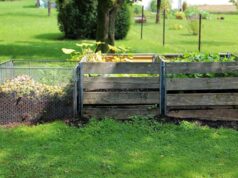Gardens are places of beauty and creativity, places to let your inspiration run wild. And what better way to explore your imaginative side than by making your own DIY mosaic garden stepping stones? Easy to create and fun for the whole family, this simple project can be completed in a weekend and is sure to bring delight and color to your garden for years to come.
What you need:
- Concrete stepping stones
- Thin-Set mortar
- Grout
- Notched trowel, with ¼ to ½” notches
- Grout float or a puddy knife
- Protective mask, rubber gloves and safety glasses
- Cardstock and pencil or premade pattern (optional)
- Drop cloth (optional)
- Hammer or tile nippers
- Sponge
- Soft cloth
- Broken pieces of china, tiles, glass, marbles, stones – let your imagination run wild!
Important safety tips before you begin:
- If you are mixing your own mortar and grout, be sure to do so in a well-ventilated area, ideally outside. A mask and protective gloves are also recommended for this step of the process.
- When breaking your mosaic pieces, wear suitable protective eyewear and handle sharp edges with care.
- Adult supervision is recommended for this project. Although this project is great for children and adults alike, mosaic pieces have sharp edges and should be handled with care.
How to create your mosaic garden stepping stones:
Step 1: Plan your design.
Before beginning, you will want to plan out your mosaic design. You can browse through mosaic books, download mosaic patterns online or create your own. Patterns can be drawn free-hand or you can create stencils using thick cardstock. Pick a design that speaks to you and works with your garden. Popular ideas include geometric designs, suns, moons and stars, assorted flowers, hummingbirds, butterflies and more. You can also make very personal mosaic stones by creating designs depicting family members, a beloved pet or a favorite quote or saying.
Take stock of your mosaic supplies, what tiles, glass and other items you’ll be using and plan the colors you would like to use in your stone. If you plan on making multiple stepping stones, consider using similar themes and colors throughout your designs.
Step 2: Gather your mosaic pieces.
When choosing what to use in your mosaic design, get creative! Found objects like marbles, sea glass and seashells, stones and many crystals work well. You can also use tile pieces or broken bits of pottery, glass and ceramic. If you have a broken heirloom teapot, your mosaic stepping stone is a great way to upcycle it and give it a new life.
If you have larger tiles or pieces of glass or ceramic that need to be broken, be sure to wear protective gloves and safety glasses. Tile nippers can make easy work of breaking down larger items into small mosaic pieces; however, in a pinch, wrap your glass and ceramic items in a drop cloth before breaking them with a hammer until they are the size you need. Mosaic pieces can come in a range of sizes and shapes, but sizes ranging from ½ to 1” are ideal.
Step 3: Presoak your concrete stepping stones.
Presoaking your stepping stones until they are thoroughly wet will help the mortar better adhere to your stones.
Step 4: Apply mortar.
If you are mixing your own Thin-Set mortar, follow the manufacturer’s instructions, adding water little by little until the mortar has achieved a consistency of runny peanut butter. For an easier solution, simply use a premixed mortar.
Using a notched trowel, apply ¼ to ½” of mortar to your stone. Considering that mortar will begin to set in about 15 minutes, you will want to have your design ready to go and you may want to apply mortar in sections to prevent rapid drying.
Step 5: Create your mosaic design.
If you’re using a pattern, lightly place it on top of your mortar. Working from the outside in, trace your pattern with mosaic pieces until you have outlined your pattern, then finish up by laying the remainder of your mosaic pieces inside the outline. If you’re creating a freehand design, simply begin laying mosaic pieces, paying attention to how you can combine colors, textures and designs in interesting ways.
As you lay your mosaic, press individual pieces firmly into your mortar so that the mortar rises up slightly on either side to ensure a proper hold. While you work, be sure to leave some space between pieces to allow for grout. If areas appear uneven, extra mortar can be applied under individual pieces as needed to create an even surface.
Step 6: Clean up excess mortar.
Using a damp sponge, remove any extra mortar and allow your stepping stone to dry overnight.
Step 7: Apply your grout.
After allowing your mortar to set fully, you will need to grout your mosaic design. Grouts come in a range of colors, so select one that complements your design. You can use a premixed grout or mix your own by following the manufacturer’s instructions.
Place a large mound of prepared grout on your stepping stone and spread it across your design with a puddy knife, grout float or kitchen spatula. You will want to press the grout firmly into your design to ensure all spaces between individual mosaic pieces are completely filled and coat the sides of your stepping stone with grout as well.
Step 8: Clean up your design.
Wipe up excess grout using a damp sponge and working across your design in all directions. Be sure to clean out your sponge frequently with fresh water and take care not to remove too much grout. After cleaning up your design, allow your stepping stone to dry for 24 to 48 hours.
After 48 hours, buff your stone with a soft cloth to remove any remaining grout residue.
Step 9: Place your stepping stone.
Now that you’ve completed your DIY mosaic stepping stone it’s ready to be placed in your garden. Mosaic stepping stones make great additions to garden beds, help to form pathways to bird baths and other frequently used garden features and much more. Choose a proper location for your stone and enjoy!
Helpful hints for creating and maintaining your mosaic:
- If you’re mixing your own grout or mortar, add water slowly to ensure you don’t dilute your product.
- Humidity and temperature have a strong impact on how grout and mortar will set. If possible, create your mosaic stones on a day when humidity is low and temperatures are in the 60 to 70° F range.
- If any of your mosaic pieces are loose or fall off, simply reattach them with a tile adhesive.








